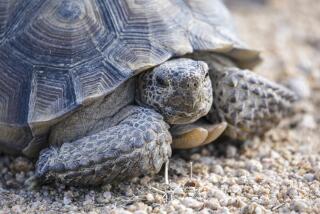Spanish Park Fighting to Save Its Desert Gazelles
- Share via
ALMERIA, Spain — In the shadows of a Moorish fortress in southern Spain, desert gazelles wait to return to their natural habitat in the western Sahara.
Poaching, colonial military garrisons across the region and finally the war in which Polisario guerrillas have been fighting Morocco made this natural habitat a dangerous place for animals.
Three subspecies of the Dama, Dorcas and Cuvieri gazelles and the goatlike Barbary sheep have been saved from extinction at a special park in Almeria, Europe’s driest corner.
The park, run by the government’s Dry Zone Experimental Research Center, was set up 17 years ago with a few specimens of each of the four species. It now houses about 250 animals and is the only program in the world designed to save the west Saharan subspecies from dying out.
“The aim is to have a stable population of about 400 animals, or about 100 of each species,” said park director Juan Ramon Vericad, “and then start the process of reintroducing them to their natural habitat.”
That involves studying the environment to make sure that it really is suitable for the animals to return and to make sure the factors that threatened the animals are no longer there.
It also depends on cooperation between Spain and the other countries involved--Morocco, Senegal and Mauritania.
Peace in the western Sahara would help.
U.N. mediators have recently reported progress in seeking an end to the 12-year war through a referendum to decide the future of the former Spanish colony.
“If there was peace, the animals could return. But it would depend on the new government being interested, and with the studies to be done, it would be at least a couple of years,” Vericad said.
The animals are cordoned off behind wire fences, but otherwise they live in an environment remarkably similar to their natural one, surrounded by cacti, acacia trees and palms.
Almeria, with a hot, sunny climate and an average rainfall of less than 12 inches a year, has been described as a slice of Africa’s dry belt tacked on to the southern corner of Europe.
The Barbary sheep clamber around on an artificial rock face. They look like large goats with shaggy beards but are powerful enough to kill a person if threatened.
The nimble Cuvieri mountain gazelles, the piebald Dama gazelles and the pale Dorcas gazelles, not much bigger than greyhounds and just as delicate, frolic in the dust below.
Shielded from the noise and bustle of Almeria by the walls of the fortress, a legacy of Moorish occupation of Spain, the animals are now breeding successfully enough for the next part of the program to begin.
Reproduction has had to be carefully controlled. With so few animals to start with, inbreeding could create problems such as loss of fertility or resistance to disease.
To keep the species healthy, animals showing signs of defects are not included in the breeding program.
Some animals have already been returned to Senegal, where they are becoming acclimated to local conditions and will be set free within a few years.
“You can’t just set them free from one day to the next,” Vericad said. “It’s a slow process--there are a lot of things you have to teach them, such as adapting them to find their own food again.”
More to Read
Sign up for Essential California
The most important California stories and recommendations in your inbox every morning.
You may occasionally receive promotional content from the Los Angeles Times.













